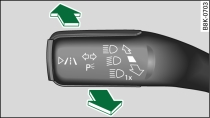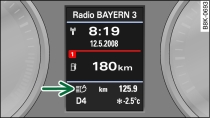
- Fig. 1 Turn signal lever for operating the main beam assist

- Fig. 2 Indicator lamp for main beam assist
Applies to vehicles: with main beam assist
The main beam headlights are switched on and off automatically, depending on the traffic conditions.
Description
When the main beam assist is activated, the main beam headlights are switched on and off automatically depending on the ambient light level and traffic conditions. The main beams are switched on for optimum vision whenever this is possible without inconveniencing other drivers. The driver is then free to concentrate on the road. The system is controlled by a sensor on the front side of the interior mirror. Of course, you can intervene at any time by operating the main beams manually.
Activating the main beam assist
Manual intervention
You can dip the headlights manually at any time. To reactivate the main beam assist, briefly press the turn signal lever forwards again.
If the main beam assist has activated the dipped headlights but you want to switch on the main beams, briefly press the turn signal lever forwards. The main beams will be switched on and the system deactivated (you will now have to dip the headlights manually if necessary). To reactivate the system, briefly press the lever forwards again.
Messages in the instrument cluster display
If a system fault occurs, the following message will appear in the display:
main beam assist: system fault
The system should be checked by an Audi dealership or other qualified workshop.
If the windscreen is dirty or vision is impaired, e.g. by vignettes, the following message will appear in the display:
main beam assist: please clean windscreen
WARNING!
The main beam assist is only intended to assist the driver. The driver must always ensure that the headlights are used when required, and may have to switch them on manually when the light conditions or visibility are poor. In the following situations, the functionality of the system may be restricted and manual intervention may be necessary:
- Hazardous weather conditions such as fog, heavy rain and snow or water splashes.
- Roads on which oncoming traffic is partially concealed (e.g. on motorways).
- Indiscernible road users (e.g. pedestrians or cyclists with poor lighting)
- Tight corners, steep hill crests or valleys
- Poorly lit towns
- Highly reflective objects, such as road signs
- Area of the windscreen in front of the interior mirror misted up, dirty, frosted or covered by stickers
- Sensor on the inside of the interior mirror dirty
